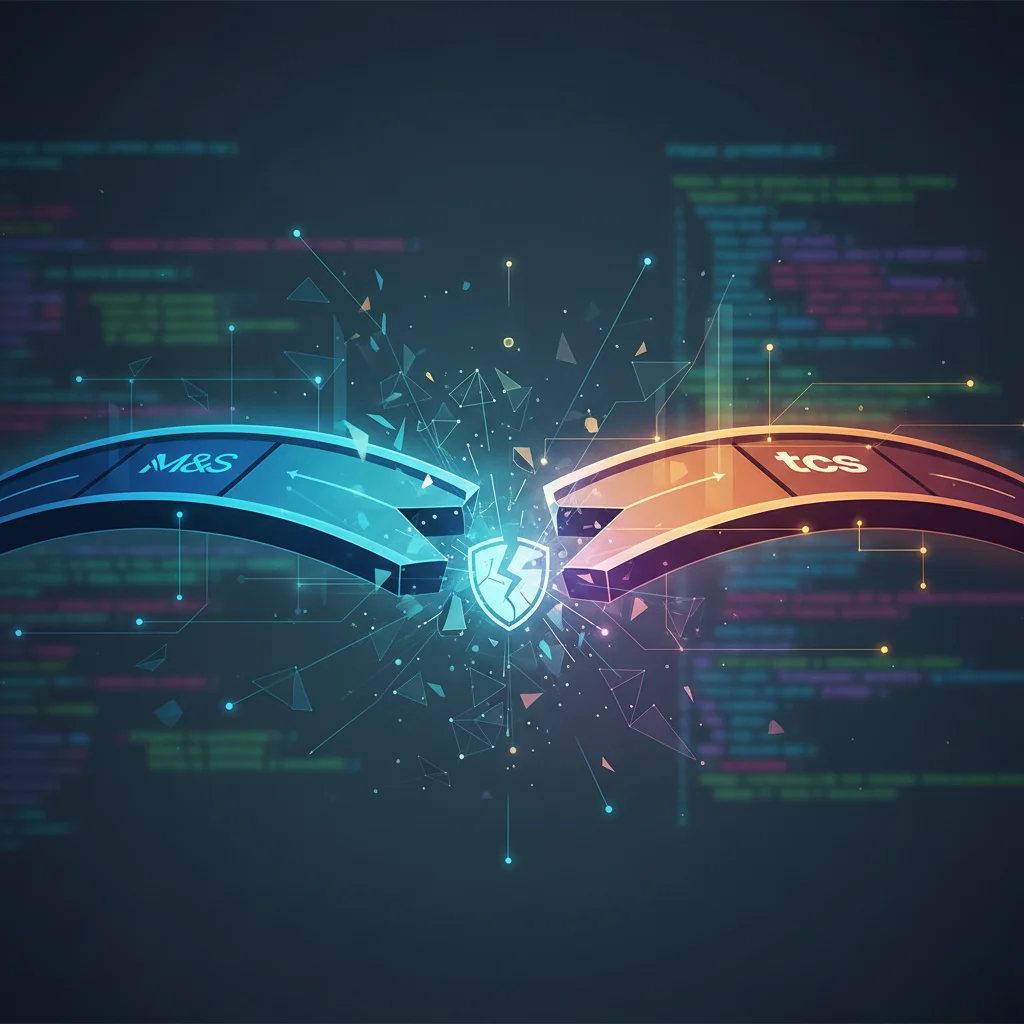
After the Breach: Why the M&S and TCS Split is a Landmark Moment for Corporate Tech
A Partnership Dissolved: More Than Just a Contract
In the world of corporate giants, partnerships are forged and dissolved every day. But when a household name like Marks & Spencer (M&S) decides to abruptly end a major IT contract with a global tech behemoth like Tata Consultancy Services (TCS), it’s more than just a line item in a quarterly report. It’s a seismic event that sends ripples through the entire technology and business landscape. The catalyst? A damaging cyber attack that, while not officially blamed on TCS, occurred on their watch.
According to the Financial Times, M&S is pulling the plug on its IT service desk contract with the Indian provider and bringing the entire operation back in-house. This move comes in the wake of a significant cybersecurity incident, and although TCS conducted an internal investigation and exonerated itself from being the source of the breach, the damage to the relationship was clearly done. The trust was broken.
This isn’t just a story about one company and one vendor. It’s a cautionary tale for every entrepreneur, developer, and tech professional. It’s a deep-dive into the complex, high-stakes world of third-party risk, the evolving role of cybersecurity, and the strategic dilemma of outsourcing versus in-house control in an age of relentless digital threats.
The Hidden Risks of the Supply Chain: Your Vendor is Your Vulnerability
For decades, the logic of outsourcing non-core functions like IT help desks was ironclad. Why build and manage a costly internal team when you can leverage the scale, expertise, and cost-efficiency of a global specialist? Companies like TCS built multi-billion dollar empires on this premise. However, the M&S incident throws a harsh spotlight on the flip side of that coin: risk transference.
When you outsource a function, you don’t eliminate risk; you merely transfer it. Your vendor’s security posture becomes your security posture. Their vulnerabilities become your vulnerabilities. This is the essence of “third-party risk” or “supply chain attacks,” a vector that cybercriminals are exploiting with devastating effectiveness.
An IT service desk is a particularly juicy target. It’s the nerve center of a company’s daily tech operations. Its staff have privileged access to user accounts, internal systems, and sensitive data. A compromise here isn’t just a data leak; it’s like handing a master key to the most secure areas of your digital kingdom. For M&S, a retailer with a massive online presence and a treasure trove of customer data, the potential fallout from such a breach is catastrophic.
The TikTok Code: How an AI Startup Outsmarted the World
This incident forces a critical re-evaluation of the traditional outsourcing model. The question is no longer just “Who can do it cheaper?” but “Who can do it more securely?” and “How much control are we willing to sacrifice for convenience?”
The Great Debate: In-House vs. Outsourced IT
M&S’s decision to bring its service desk back in-house represents a significant pendulum swing. Let’s break down the strategic calculus that likely went into this decision, a thought process relevant for any organization, from a global retailer to a nimble startup.
| Factor | Outsourced IT (The Old Model) | In-House IT (The New Imperative) |
|---|---|---|
| Control & Oversight | Limited. Reliant on vendor’s policies, SLAs, and reporting. A “black box” effect can occur. | Total. Direct control over hiring, training, security protocols, and technology stack. |
| Security Posture | Dependent on the vendor. A single vendor can be a single point of failure for many clients. | Customizable and integrated directly into the company’s overall cybersecurity strategy. Faster response to internal threats. |
| Cost Structure | Often lower operational cost due to economies of scale. Predictable, contract-based pricing. | Higher initial investment and ongoing overhead (salaries, benefits, tools). |
| Agility & Innovation | Can be slow to adapt. Changes often require contract renegotiations and navigating vendor bureaucracy. | Highly agile. Can rapidly adopt new tools, pivot strategies, and integrate with internal development (DevOps) cycles. |
| Accountability | Blurred lines. As seen with M&S/TCS, attribution can be disputed, leading to a “blame game.” | Clear and direct. The buck stops with internal leadership. |
The In-House Renaissance: Powered by AI, Automation, and the Cloud
Bringing a service desk in-house today is a world away from what it meant ten or fifteen years ago. The reason the outsourcing boom happened in the first place was that running an efficient, 24/7 help desk was a complex and expensive human-powered endeavor. That is no longer the case. A new generation of technology has democratized the tools needed to run a world-class IT operation internally.
This is where the conversation pivots to innovation and modern software. Here’s how technology is making the in-house model viable and even preferable:
- Artificial Intelligence (AI) and Machine Learning (ML): Modern IT Service Management (ITSM) platforms are infused with AI. AI-powered chatbots can handle a huge percentage of Level 1 support requests—password resets, software access, basic troubleshooting—instantly and without human intervention. Machine learning algorithms can analyze ticket trends, predict future problems, and identify root causes of recurring issues, turning the service desk from a reactive cost center into a proactive, data-driven intelligence hub.
- Automation: The power of automation cannot be overstated. Routine tasks that once required a technician—like provisioning a new laptop, onboarding a new employee’s software access, or patching a vulnerability—can now be fully automated. This frees up the human team to focus on high-value, complex problems that require critical thinking.
- Cloud and SaaS: The rise of the cloud and Software-as-a-Service (SaaS) has eliminated the need for massive on-premise infrastructure. A company like M&S can now stand up a powerful, globally accessible service desk platform from providers like ServiceNow, Jira Service Management, or Freshservice in a fraction of the time and with a fraction of the upfront capital. This agility is a game-changer for businesses of all sizes, especially startups.
By leveraging this modern tech stack, M&S can build an in-house team that is leaner, more technically skilled, and more deeply integrated with the company’s culture and security objectives than any outsourced alternative could be. They can ensure that the team is trained on their specific security protocols and that every action is logged and audited within their own controlled environment.
The Coder, The Kingpin, and The Ransomware: A Cybercrime Love Story Gone Wrong
Lessons for Every Leader, Developer, and Entrepreneur
The M&S and TCS saga is a macrocosm of the challenges faced by organizations of all sizes. Whether you’re a Fortune 500 company or a five-person startup, the principles remain the same. Here are the actionable takeaways:
- Vet Your Vendors Relentlessly: Don’t just look at their sales pitch and pricing. Scrutinize their security certifications (like SOC 2, ISO 27001), their data handling policies, and their incident response plans. Ask the hard questions. How do they train their staff? How do they enforce access controls? What are their procedures in the event of a breach? Make security a primary criterion in your procurement process. The lowest bidder is often the highest risk.
- Embrace a “Zero Trust” Architecture: The old model of a “trusted” internal network and an “untrusted” external world is dead. A Zero Trust approach assumes that no user or device is inherently trustworthy, whether they are inside or outside the network. Every access request must be verified. This philosophy extends to your vendors. Grant them the absolute minimum level of access required to do their job—nothing more.
- Invest in In-House Expertise (Even if You Outsource): Even if you use third-party providers, you need a strong internal team that can manage those vendors effectively. You need in-house cybersecurity talent that can audit your partners, understand their reports, and challenge their assumptions. This team acts as your internal advocate and your last line of defense.
- Build Security into Your Code: For developers and tech leaders, this is a call to action. Secure programming practices and a “security by design” mindset are non-negotiable. The most robust firewalls in the world can’t protect against an application with a fundamental vulnerability. Integrating security into the entire software development lifecycle (DevSecOps) is essential for building resilient systems.
The Chip War Just Shifted Gears: Why Your Next Car is on the Geopolitical Frontline
The Future is About Control
The decision by M&S to end its contract with TCS, a partnership that likely represented tens of millions of pounds (source), was not made lightly. It signals a profound shift in corporate strategy, a recognition that in the current threat landscape, direct control over critical IT functions and security is the ultimate competitive advantage.
This event may well be remembered as a turning point—the moment when the blind faith in the cost-saving promise of large-scale outsourcing began to wane, replaced by a more sober, security-first approach. It’s a future where technology like AI and automation empowers companies to own their destiny, building resilient, agile, and secure operations from the inside out. The M&S and TCS breakup isn’t just the end of a contract; it’s the beginning of a new chapter in how businesses think about technology, risk, and trust.


